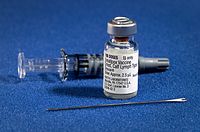
Rotavirus vaccine effectiveness in low-income settings: An evaluation of the test-negative design
Sign Up to like & getrecommendations! Published in 2017 at "Vaccine"
DOI: 10.1016/j.vaccine.2016.10.077
Abstract: Highlights • Rotavirus vaccines (RVs) have been recently introduced in low-income settings.• Accurate post-introduction monitoring of RV effectiveness is important.• The test-negative design (TND) is used to measure RV effectiveness.• The TND was evaluated using… read more here.
Keywords: test negative; negative design; income settings; low income ... See more keywords

Computational Competitive and Negative Design To Derive a Specific cJun Antagonist.
Sign Up to like & getrecommendations! Published in 2018 at "Biochemistry"
DOI: 10.1021/acs.biochem.8b00782
Abstract: Basic leucine zipper (bZIP) proteins reside at the end of cell-signaling cascades and function to modulate transcription of specific gene targets. bZIPs are recognized as important regulators of cellular processes such as cell growth, apoptosis,… read more here.
Keywords: negative design; competitive negative; computational competitive; cjun antagonist ... See more keywords

Temporal Confounding in the Test Negative Design.
Sign Up to like & getrecommendations! Published in 2020 at "American journal of epidemiology"
DOI: 10.1093/aje/kwaa084
Abstract: In the test negative design, routine testing at healthcare facilities is leveraged to estimate the effectiveness of an intervention such as a vaccine. The odds of vaccination for individuals who test positive for a target… read more here.
Keywords: test negative; negative design; confounding test; temporal confounding ... See more keywords

Severity Adjustment in the Test-Negative Design.
Sign Up to like & getrecommendations! Published in 2021 at "American journal of epidemiology"
DOI: 10.1093/aje/kwab066
Abstract: The test-negative design is often used to estimate vaccine effectiveness in influenza studies, but has also been proposed in the context of other infectious diseases, such as cholera, dengue or Ebola. It was introduced as… read more here.
Keywords: severity adjustment; test negative; negative design; test ... See more keywords

The use of test-negative controls to monitor vaccine effectiveness: a systematic review of methodology.
Sign Up to like & getrecommendations! Published in 2019 at "Epidemiology"
DOI: 10.1097/ede.0000000000001116
Abstract: BACKGROUND The test-negative design is an increasingly popular approach for estimating vaccine effectiveness (VE) due to its efficiency. This review aims to examine published test-negative design studies of VE and to explore similarities and differences… read more here.
Keywords: vaccine effectiveness; negative design; test negative; methodology ... See more keywords

Investigating confounding in network‐based test‐negative design influenza vaccine effectiveness studies—Experience from the DRIVE project
Sign Up to like & getrecommendations! Published in 2022 at "Influenza and Other Respiratory Viruses"
DOI: 10.1111/irv.13087
Abstract: Background: Establishing a large study network to conduct influenza vaccine effectiveness (IVE) studies while collecting appropriate variables to account for potential bias is important; the most relevant variables should be prioritized. We explored the impact… read more here.
Keywords: network; vaccine effectiveness; influenza vaccine; negative design ... See more keywords

Influenza Vaccine Effectiveness Estimates among US Department of Defense Adult Beneficiaries over Four Consecutive Influenza Seasons: A Test-Negative Design Study with Different Control Groups
Sign Up to like & getrecommendations! Published in 2021 at "Vaccines"
DOI: 10.3390/vaccines10010058
Abstract: A test-negative design study with different control groups (influenza test-negative controls, non-influenza virus positive controls, and pan-negative controls) was conducted to assess inactivated influenza vaccine effectiveness (VE) in adults aged ≥18 years, 2016–2017 through 2019–2020… read more here.
Keywords: influenza seasons; design study; test negative; influenza ... See more keywords